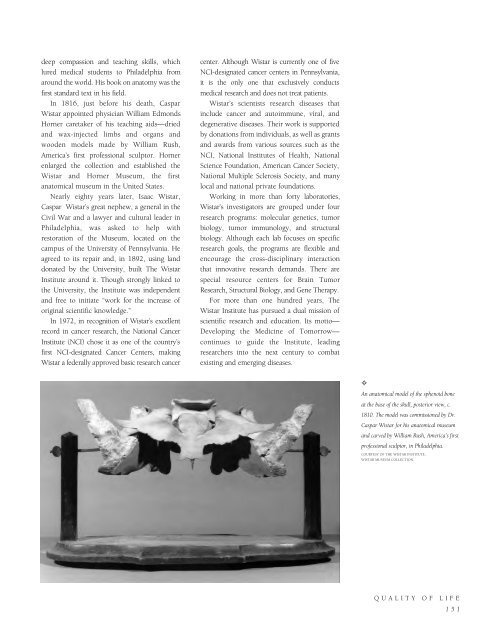Historic Philadelphia
An illustrated history of the city of Philadelphia, paired with the histories of companies, families and organizations that make the region great.
An illustrated history of the city of Philadelphia, paired with the histories of companies, families and organizations that make the region great.
Create successful ePaper yourself
Turn your PDF publications into a flip-book with our unique Google optimized e-Paper software.
deep compassion and teaching skills, which<br />
lured medical students to <strong>Philadelphia</strong> from<br />
around the world. His book on anatomy was the<br />
first standard text in his field.<br />
In 1816, just before his death, Caspar<br />
Wistar appointed physician William Edmonds<br />
Horner caretaker of his teaching aids—dried<br />
and wax-injected limbs and organs and<br />
wooden models made by William Rush,<br />
America’s first professional sculptor. Horner<br />
enlarged the collection and established the<br />
Wistar and Horner Museum, the first<br />
anatomical museum in the United States.<br />
Nearly eighty years later, Isaac Wistar,<br />
Caspar Wistar’s great nephew, a general in the<br />
Civil War and a lawyer and cultural leader in<br />
<strong>Philadelphia</strong>, was asked to help with<br />
restoration of the Museum, located on the<br />
campus of the University of Pennsylvania. He<br />
agreed to its repair and, in 1892, using land<br />
donated by the University, built The Wistar<br />
Institute around it. Though strongly linked to<br />
the University, the Institute was independent<br />
and free to initiate “work for the increase of<br />
original scientific knowledge.”<br />
In 1972, in recognition of Wistar’s excellent<br />
record in cancer research, the National Cancer<br />
Institute (NCI) chose it as one of the country’s<br />
first NCI-designated Cancer Centers, making<br />
Wistar a federally approved basic research cancer<br />
center. Although Wistar is currently one of five<br />
NCI-designated cancer centers in Pennsylvania,<br />
it is the only one that exclusively conducts<br />
medical research and does not treat patients.<br />
Wistar’s scientists research diseases that<br />
include cancer and autoimmune, viral, and<br />
degenerative diseases. Their work is supported<br />
by donations from individuals, as well as grants<br />
and awards from various sources such as the<br />
NCI, National Institutes of Health, National<br />
Science Foundation, American Cancer Society,<br />
National Multiple Sclerosis Society, and many<br />
local and national private foundations.<br />
Working in more than forty laboratories,<br />
Wistar’s investigators are grouped under four<br />
research programs: molecular genetics, tumor<br />
biology, tumor immunology, and structural<br />
biology. Although each lab focuses on specific<br />
research goals, the programs are flexible and<br />
encourage the cross-disciplinary interaction<br />
that innovative research demands. There are<br />
special resource centers for Brain Tumor<br />
Research, Structural Biology, and Gene Therapy.<br />
For more than one hundred years, The<br />
Wistar Institute has pursued a dual mission of<br />
scientific research and education. Its motto—<br />
Developing the Medicine of Tomorrow—<br />
continues to guide the Institute, leading<br />
researchers into the next century to combat<br />
existing and emerging diseases.<br />
✧<br />
An anatomical model of the sphenoid bone<br />
at the base of the skull, posterior view, c.<br />
1810. The model was commissioned by Dr.<br />
Caspar Wistar for his anatomical museum<br />
and carved by William Rush, America’s first<br />
professional sculptor, in <strong>Philadelphia</strong>.<br />
COURTESY OF THE WISTAR INSTITUTE,<br />
WISTAR MUSEUM COLLECTION.<br />
QUALITY OF LIFE<br />
151
















